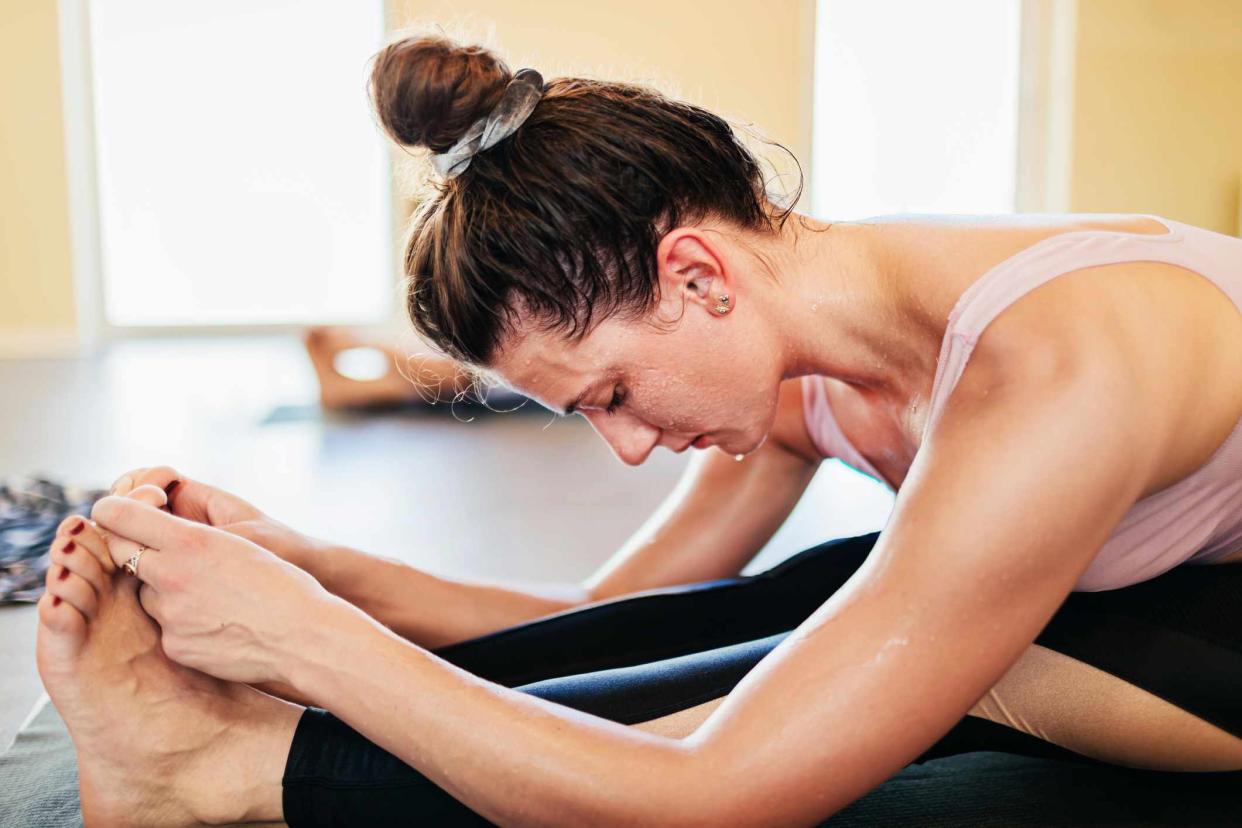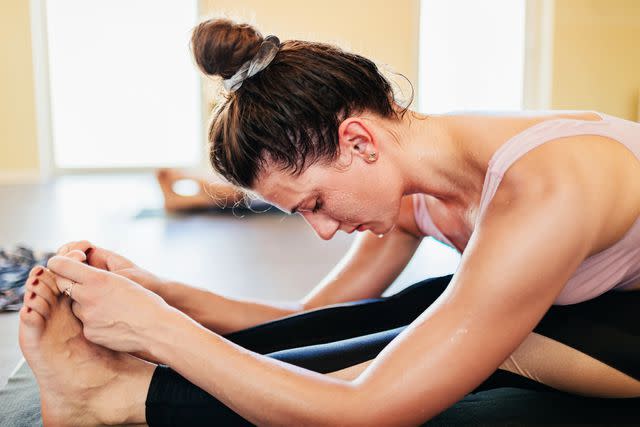What to Know Before Your First Hot Yoga Class

Tom Werner / Getty Images
Medically reviewed by Forest Miller, MSOT, OTR/L
Hot yoga is like traditional yoga in that people often come to the practice for similar reasons—to improve physical health, calm the mind, reduce stress, and increase flexibility and range of motion in the joints.
Many of the same poses practiced in traditional yoga are done in hot yoga. Some hot yoga classes follow an exact sequence of poses for every class, while others vary the sequences based on the instructor’s methods of teaching and the goals for that individual class.
Whether the poses vary or not, there is one constant variable in hot yoga, and that is the temperature—which is always elevated.
Continue reading to discover the benefits of hot yoga, whether it is safe for beginners, the origins of Bikram yoga, and what to do before and after a hot yoga class.

Tom Werner / Getty Images
Hot Yoga: Safe and Good for Beginners?
Hot yoga can be safe for beginners. However, as with all physical activity, it’s important to assess your overall health and, in some cases, consult your healthcare provider before beginning a new regimen.
People with certain conditions (such as multiple sclerosis) may find that the heat in hot yoga can trigger symptoms, and it may not be suitable for beginners.
Places that offer hot yoga classes will often have specific classes designed for beginners. These classes may go at a slower pace. The instructor will commonly spend more time explaining and demonstrating how to move in and out of the poses to help you adjust to the new and possibly unfamiliar movements.
For some people, the poses may be familiar, but the addition of heat to the yoga practice may be new. In this case, talk to the teacher and let them know you’ve done yoga but are new to hot yoga.
The teacher may have specific tips to help you adjust to being in a heated room or remind you that it’s OK to take more frequent breaks than you might be used to in traditional yoga classes.
Being a beginner can be scary, but it can also be invigorating, so embrace these moments. The experience of something new can revive your excitement for yoga and give you something to look forward to.
Temperatures in hot yoga range from 90–105 degrees Fahrenheit, depending on the studio and type of hot yoga.
Five Benefits of Hot Yoga
As a holistic practice, hot yoga offers both physical and mental benefits.
Improves Overall Health
Exercise is a well-known method for improving overall health and fitness. Engaging in regular movement, such as hot yoga, can promote better sleep, reduce obesity and cardiovascular disease rates, and improve the immune system.
People who practice yoga also tend to engage in more health-promoting behaviors, such as eating more nutritious foods and avoiding health-damaging activities like smoking.
Hot yoga can also help people who cannot tolerate high-intensity exercise improve their overall fitness.
High-intensity exercise can help improve overall fitness, but for those with certain conditions such as obesity, cardiovascular disease, or chronic obstructive pulmonary disease, high-intensity exercise may not be suitable. Hot yoga is often accessible to people with these conditions.
Increases Range of Motion
Hot yoga can help improve flexibility and range of motion. People who practice yoga increase the range of motion of their hips, elbows, knees, and shoulders. Compared to room-temperature yoga, hot yoga has a greater effect on hip mobility.
Weight Loss Aids
Hot yoga is a physical activity that can help you lose weight. Several different factors influence weight loss from hot yoga. These include the high temperature, the increased overall movement, the increased lean muscle mass, and changes in eating habits.
A study of people who practiced yoga explored their weight loss experiences. These people found that their body composition changed to include more muscle. They also tended to shift their eating habits to healthier ones, and the yoga community itself promoted their health.
Another study of 50 overweight women who practiced hot yoga for a year found that weight and body fat percentages decreased. When citing research or health authorities, we use the terms for sex or gender from the source.
Though there are claims stating Bikram yoga can burn up to 1,000 calories a session, these are unfounded and unstudied. Calorie expenditure is increased similarly during hot yoga and room-temperature yoga, though an exact number is not known.
Lowers Stress Levels
Stress can have a big effect on health, putting you at higher risk of things like cardiovascular disease and chronic inflammation. As a mind-body practice, hot yoga can reduce stress.
With regular practice, yoga can decrease the hormones and chemicals in the body that are associated with stress, such as cortisol. People who practice yoga have better stress resilience and experience an overall increase in well-being.
Reduces Anxiety and Depression
Regular yoga practice can help reduce anxiety and depression and improve overall mental health.
Though the evidence for yoga's effect on diagnosed mental health conditions is not as promising, people going through stressful life situations such as health conditions had improved anxiety and depressive symptoms.
A study that followed participants during a three-month yoga retreat found that participants experienced improvements in depression and anxiety.
Where Did Bikram Hot Yoga Originate?
Bikram Choudhury founded Bikram hot yoga. The practice consists of a 26-pose sequence in a heated room. Bikram set up his first studio in Los Angeles in 1973 and published his first book, Bikram’s Beginning Yoga Class, in 1978. In 20 years, it expanded to dozens of countries.
Choudhury left the United States in 2016 after legal difficulties, lawsuits, and judgments. Reportedly, many hot yoga studios rebranded themselves to distance their businesses from his name.
Before a Hot Yoga Class
Prepare for a hot yoga class by considering that you will be moving and exerting yourself in a hot room. Many people find that unrestrictive (but not loose) clothing allows them to move freely while keeping everything in place.
Many fitness brands on the market make sweat-wicking movable fabrics for yoga.
If you present as a female, appropriate attire may look like a sports bra or tank and biker shorts. If you present as a male, you might wear a pair of shorts with no shirt or a form-fitting tank top.
Bring a towel with you to class. You can use it to wipe sweat from your body and the mat. You can also find yoga towels that are the length of the mat so you can lay them down to avoid working on a slippery surface.
If you are worried about your body odor during hot yoga, maintain good hygiene and use deodorant or antiperspirant. Do not use strong perfumes or colognes, which can disturb the experience for others.
Depending on the studio, you may be encouraged to bring water to sip throughout the practice.
If you are new to hot yoga, arrive early and speak with the instructor. Let them know if you have injuries they need to be aware of so they can modify poses for you, and ask questions if you are unsure about how to set yourself up in the room.
After a Hot Yoga Class
After a hot yoga class, you will most likely be drenched in sweat. Be sure to rehydrate. Take your time moving out of the room to avoid light-headedness.
In some studios, your instructor may offer you the option to continue to lie in Savasana, the final resting pose. If you feel great where you are, lay there for as long as possible, soaking in the effects of the practice.
Some studios have showers in the bathrooms so you can rinse off and cool down after practice. Otherwise, you may need to wait until you return home.
Summary
Hot yoga is yoga practiced in a heated room that ranges in temperature from 90–105 degrees Fahrenheit. The practice is suitable for beginners if they don’t have conditions that high temperatures can aggravate.
The benefits of hot yoga include improved overall health, weight loss, reduced stress, increased range of motion, and a reduction in anxiety and depressive symptoms.
Prepare for a hot yoga class by wearing appropriate clothing and familiarizing yourself with the instructor and ways to take breaks if needed. After hot yoga, rehydrate, shower, and enjoy the effects of the practice.

